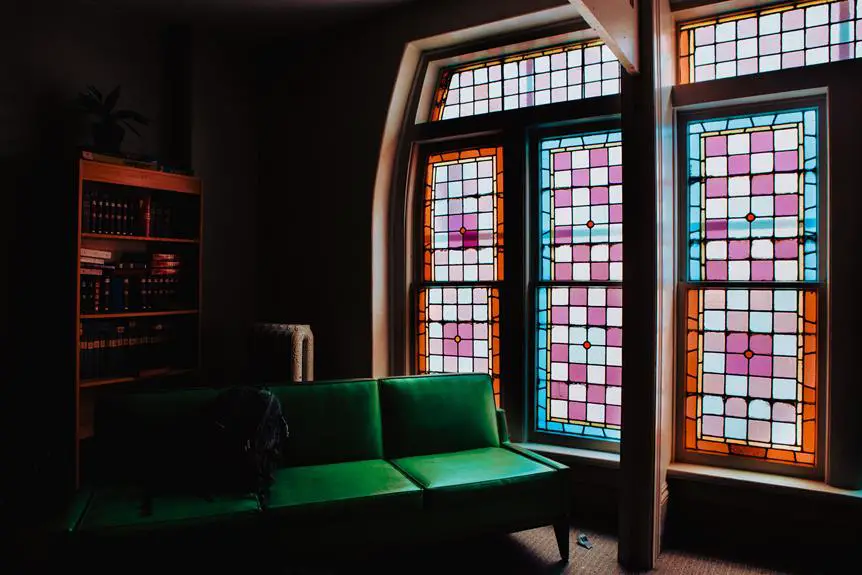You adore sinking into your couch, but the thought of spills and stains constantly nags at you. Choosing the best stain protector for your couch is crucial to preserving its beauty and longevity.
In this guide, you will explore the options available and learn how to expertly shield your couch from life's inevitable mishaps. From understanding the basics to mastering the application process, you'll gain the knowledge needed to make an informed decision.
By the end, you'll be equipped with the expertise to select the perfect stain protector, ensuring that your couch remains a pristine sanctuary for relaxation.
Key Takeaways
- Stain protectors create a barrier on the fabric to repel liquids and prevent stains from setting in.
- There are different types of stain protectors available, such as fluoropolymer-based and water-based options, as well as DIY fabric treatments.
- Specialized stain protectors are available for leather couches, but fluoropolymer-based protectors for fabric couches can also be effective.
- Proper application and maintenance of stain protectors, including regular reapplication and vacuuming, are essential for maintaining their effectiveness.
Understanding Stain Protector Basics
When you're considering stain protectors for your couch, it's important to understand the basics of how they work and why they're beneficial. Understanding the chemical formulations of stain protectors is crucial. These protectors typically contain fluorochemicals or silicones that create a barrier on the fabric, repelling liquids and preventing them from being absorbed. This barrier allows for easier cleanup and prevents stains from setting in.
Professional application techniques are also important to consider. Many stain protectors require a thorough and even application to ensure maximum effectiveness. Professional upholstery cleaners have the expertise to apply the protectant evenly and consistently, ensuring that every inch of your couch is adequately protected.
Types of Stain Protectors for Fabric Couches
To protect your fabric couch from stains, consider applying a fluoropolymer-based stain protector. When choosing the best stain protector for your fabric couch, you'll want to consider various options that offer effective protection. Here are some types of stain protectors to consider:
- Fluoropolymer-based protectors: These provide excellent stain resistance and are commonly used by professionals for their durability and effectiveness.
- Water-based protectors: These are eco-friendly options that are easy to apply and offer good protection against liquid spills and stains.
- DIY fabric treatments: Some stain protectors come in DIY kits, allowing you to treat your fabric couch at your convenience.
- Expert application techniques: Professional upholstery cleaners may offer expert application techniques using specialized equipment, ensuring thorough and long-lasting protection for your fabric couch.
When considering the types of stain protectors for fabric couches, it's important to weigh the benefits and drawbacks of each option. Whether you opt for a fluoropolymer-based protector, a water-based option, or choose to go the DIY route, expert application techniques can enhance the effectiveness of the stain protector, providing you with peace of mind and a well-protected fabric couch.
Best Stain Protectors for Leather Couches
Consider using a specialized leather protector to ensure long-lasting stain resistance and protection for your couch. Applying a fluoropolymer-based stain protector for fabric couches can also be effective for leather couches, providing durable and effective protection. When it comes to leather care, it's important to choose a stain protector specifically formulated for leather to avoid damaging or discoloring the material. Professional services are also available for applying stain protectors to leather couches, ensuring thorough and even coverage.
| Stain Protector | Features | Suitability |
|---|---|---|
| Leather-specific spray | Formulated specifically for leather | Ideal for all types of leather |
| Professional application | Ensures thorough and even coverage | Recommended for delicate leather |
| Multi-surface protectant | Provides protection for various materials | Suitable for mixed-material couches |
When choosing the best stain protector for your leather couch, consider the material of your couch, your lifestyle, and the level of protection required. Whether you opt for a DIY leather-specific spray or seek professional services, ensuring your leather couch is properly protected will help maintain its appearance and longevity.
Application Process for Stain Protectors
When applying a stain protector to your couch, it's crucial to follow proper techniques to ensure even coverage and effectiveness.
Once applied, the drying and curing process is essential for the protector to bond with the fabric and provide long-lasting protection.
Additionally, maintaining the couch after application will help to prolong the effectiveness of the stain protector and keep your couch looking its best.
Proper Application Techniques
When applying stain protectors to your couch, start by thoroughly vacuuming the fabric to remove any dust and debris. This ensures that the protector adheres properly and doesn't trap any particles that could cause stains.
Follow these proper application techniques for best results:
- Test in an inconspicuous area first to check for any adverse effects on the fabric.
- Apply the protector evenly, using a sweeping motion to cover the entire surface of the couch.
- Allow the protector to fully dry before using the couch to ensure maximum effectiveness.
- Reapply the stain protector every 6-12 months, or as recommended by the product, to maintain its protective properties.
Drying and Curing Process
To ensure effective protection against stains and spills, allow the applied stain protector to fully dry before using your couch.
The drying and curing process is essential for the stain protector to bond effectively with the fabric, providing a protective barrier.
Once the stain protector is applied, it's crucial to follow the manufacturer's guidelines for the drying and curing process. This typically involves allowing the protector to air dry for a specified period, generally ranging from a few hours to a day, depending on the product.
Avoid using the couch during this time to prevent any interference with the curing process.
Properly allowing the stain protector to dry and cure will optimize its performance and longevity, ensuring the best fabric care and protection against potential stains.
Maintenance After Application
After applying the stain protector to your couch, regularly vacuuming and spot cleaning will help maintain its effectiveness and prolong the protection against stains.
Here are some tips for maintaining your couch after applying the stain protector:
- Vacuum regularly: Use a soft brush attachment to remove dust, dirt, and debris from the surface and crevices of your couch.
- Spot clean immediately: Address spills and stains promptly using a clean cloth and a gentle cleaning solution recommended for your couch material.
- Rotate cushions: Evenly distribute wear and tear by regularly rotating and flipping the cushions on your couch.
- Professional cleaning: Consider professional cleaning every 12-18 months, especially if your couch experiences heavy use or if a significant spill occurs.
Maintaining Stain Protection on Your Couch
Maintaining stain protection on your couch involves regularly cleaning and reapplying the stain protector. When it comes to cleaning methods, it's essential to vacuum your couch regularly to remove dirt and debris that can lead to stains. For spills and stains, blot the area with a clean cloth, and avoid rubbing, which can spread the stain. Prevention techniques such as using removable, washable covers or throws can also help maintain the cleanliness of your couch.
Reapplying stain protector is crucial to ensure continued protection. Consider the environmental impact and cost comparison of different stain protectors before making a choice. Some products may contain environmentally harmful chemicals, while others are eco-friendly. Additionally, compare the cost of different products and weigh it against their effectiveness.
Regular maintenance not only ensures the longevity of your couch but also contributes to a clean and inviting living space. By incorporating these cleaning methods and prevention techniques, and being mindful of the environmental impact and cost comparison when selecting a stain protector, you can effectively maintain the stain protection on your couch.
DIY Stain Protection Methods
Looking to protect your couch from stains without breaking the bank?
There are DIY stain protection methods that can be effective and budget-friendly.
From using natural fabric treatments to creating homemade stain repellents, you have options to keep your couch looking great without spending a fortune.
Natural Fabric Treatments
To effectively protect your couch from stains using natural fabric treatments, start by applying a DIY stain protection method that incorporates natural ingredients. Natural treatments offer eco-friendly options that are gentle on your couch and safe for the environment. Consider these DIY stain protection methods to keep your couch looking fresh and clean:
- Vinegar and Olive Oil: Create a mixture of vinegar and olive oil to protect your couch from stains while also conditioning the fabric.
- Baking Soda Paste: Mix baking soda with water to form a paste, then apply it to the fabric to repel stains and odors.
- Essential Oils Spray: Dilute essential oils with water and spray the solution on your couch to naturally protect it from spills and stains.
- Cornstarch Barrier: Sprinkle cornstarch on the fabric to create a protective barrier against liquids and stains.
These natural fabric treatments can help you maintain a spotless couch without harsh chemicals.
Homemade Stain Repellents
Achieve effective stain protection for your couch with homemade repellents using simple ingredients. DIY stain protection methods can be an affordable and natural alternative to commercial stain protectors. Here are some natural repellent treatments you can easily make at home:
| Homemade Stain Repellents | Ingredients |
|---|---|
| Vinegar solution | White vinegar, water |
| Baking soda paste | Baking soda, water |
| Essential oil spray | Distilled water, essential oil (e.g. lavender, tea tree) |
| Cornstarch powder | Cornstarch |
These DIY stain repellents can help protect your couch from spills and stains without the use of harsh chemicals. Apply these treatments carefully and test them on a small, inconspicuous area of your couch first. Keep your couch looking great with these simple, natural solutions.
Expert Tips for Choosing the Right Stain Protector
When choosing the right stain protector for your couch, it's important to consider the level of protection it offers against spills and stains. Here are some expert tips to help you make the best choice:
- Effectiveness and Longevity: Look for a stain protector that offers long-lasting protection against a wide range of spills and stains. Consider the durability of the product and how frequently it needs to be reapplied to ensure your couch stays well-protected over time.
- Environmental Impact and Sustainability: Consider the environmental impact of the stain protector. Opt for products that are eco-friendly, biodegradable, and free from harmful chemicals. Choosing a sustainable option not only protects your couch but also contributes to a healthier environment.
- Compatibility with Couch Material: Ensure that the stain protector is suitable for the material of your couch. Different fabrics may require specific types of protection, so it's essential to select a product that's designed to work effectively with the material of your couch.
- Ease of Application: Choose a stain protector that's easy to apply and doesn't alter the appearance or texture of your couch. Look for products that offer hassle-free application and maintain the original look and feel of your furniture.
Frequently Asked Questions
Can Stain Protectors Also Protect Against Pet Odors on Couches?
Yes, stain protectors can be effective in preventing pet odors on couches. Proper application techniques, such as evenly spraying and allowing it to fully dry, can help create a barrier against both stains and odors.
Are There Any Stain Protectors That Are Specifically Designed for Outdoor Use on Patio Furniture?
For outdoor furniture, look for a stain protector with strong weather resistance. Ensure the application is durable for longevity. Consider products designed specifically for outdoor use to provide the best protection against the elements.
Will Using a Stain Protector Affect the Color or Texture of My Fabric or Leather Couch?
Using a stain protector on your couch won't affect the color or texture if applied correctly. Follow the recommended application process for best results. It enhances durability, makes stain removal easier, and simplifies maintenance, keeping your couch looking great.
How Long Does a Typical Application of Stain Protector Last Before Needing to Be Reapplied?
Applying a stain protector typically lasts 6-12 months, depending on usage. Regular maintenance and reapplication are essential to ensure its effectiveness. Proper care and timely reapplications can help maintain the durability of the protection.
Are There Any Environmental or Health Concerns Associated With Using Stain Protectors on Furniture?
When using stain protectors on furniture, it's important to consider the environmental impact and health considerations. Look for products that are environmentally friendly and safe for indoor use, to minimize any potential negative effects.
- Can You Get Organza Wet? - April 23, 2024
- Why Is Organza so Popular? - April 23, 2024
- What Do You Wear With Organza? - April 23, 2024








